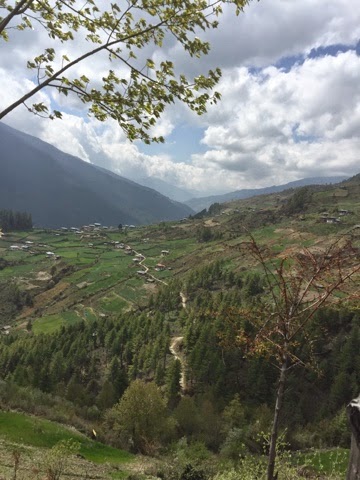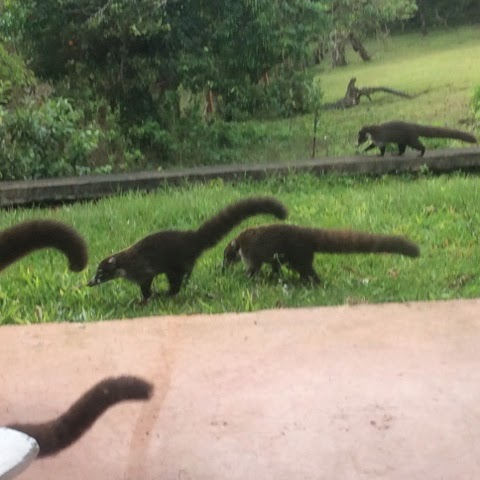Forests and Ornately Decorated Farmhouses
One of the adventures we thought would be fun to do while visiting Bhutan is to have a farm stay in a traditional farmhouse. Why? Because so much of the country is still rurual and we wanted to better understand their culture. We were offered an opportunity to visit the Haa district which is in the heart of the high country, next to Tibet. Average altitude is over 12,000 ft.
First of all driving: Roads in and out of the region have only been open since 2004 and the roads are narrow, people drive fast and one cannot see beyond the next curve. Makes for an interesting ride. The mountains are almost verticle in some places and because roads are a new thing, as are the increasing number of new cars now on the road ( mostly Indian Tata, although some Korean and Japanese), driving can be a hair raising experience even at 30 Klms an hour...especially for the person in the front seat where I tend to sit because I get car sick....such a delicate flower.....
Forests seem endless, in many cases they are still virgin. In fact, the tree line is way high up , about 13,000 ft. and it seems one is driving through wilderness although the land is quite populated.
The settlements often cluster along the rivers but others extend up the mountains with terraced fields for rice on the lower elevations in the Paro (and other valleys except Haa becuse the dieties of Paro and Haa fought and Paro won so no rice is grown in Haa). Wheat, buckwheat and potatoes yaks and dairy cows are found in Haa. Oh, and butter, lots of it and it is used for just about everything. In fact, it is the 4th "B", after Buddhism, Botany and Birds.
It seems that any land that can be cultivated is and we all found it remarkable how steep some of the fields are and yet there doesn't seem to be much erosion. I think the soil is quite sandy which may be why, that and cow and yak dung seem to work, and good drainage channels according to Cheryl who went out walking on the farm one morning.
The houses are the most amazing part of the landscape. Because all buildings must be built in the traditional atyle even the smallest farm house has ornate decorations on the outside and the roof studs which they call cornices, are painted bright colours. The larger houses look like palaces which makes the entire experience appear elegant and picturesque at the same time but that is appearances only. For example, because there were not many roads (if any) to the farms in the region before the 21st century pople walked on paths up the mountainside bringing supplies up or their cash crop down by foot. Today there are dirt roads that connect these villages and electricity and that has made for some dramatic changes in the last 10 years.
In Haa we stayed at the family home of our guide Chungdu. It is also the family home of Teswang Nidup the owner Bhutan Expeditions (and our host) and uncle of Chungdu. And, the current Prime Minister is also a relative and comes from the same village if not this family home. Apparently everybody in this village and most villages in Bhutan are related in some way. Frankly because Bhutan has only 700,000 people (about the size of San Francisco) it seems if everybody knows everybody or if they dont know each other they share a classmate or friend.
Back to our homestay. The inside of ther house is basic at best. We walked into an empty room with wood floors and a small pot belly stove used for heat and cooking. That was it. Oh, there were a couple of blankets put put by the stove for us to sit on. The walls had interesting ornate symbols painted on each wall and there were at least 10 pictures of the King, some with the Queen and some solo, tacked up alongside clothes hung up to dry. the room could have been from the middle ages. However, inside a storage chest in one wall was a large colour flatscreen TV, complete with Bollywood type movies which they watched while they ate meals. Modern liviing. Oh, they did have an indoor toilet and toilet paper and it looked like this was a fairly recent addition to the home. It was clean , although primative by western standards - we used buckets of water to flush and, of course, there was only water to wash up.
FYI. Bottled water is essential for drnking anywhere in the country. As a result the roads are littered with them notwithstanding some effort by The King to promote recycling. But where does one recycle out in the boonies? It is a problem that will have to be better addressed here- and soon because the litter problem and garbage thrown over the roadsides is disgusting and is far to frequent to pretend it doesnt exist.
I digress. Upon our arrival we were greeted by a lovely woman, Lhabgyen, (sister of .Chungdu) and given hot ginger water. Cheryl and Lorne were given what looked like the bedroom and Sheila and I had mats in what must be the formal sitting room that actually had chairs and a sofa pushed to the walls. The kitchen was basic, a cold water sink, storage and a two burner hot plate. They had a large rice cooker as well (a new and welcome invention for rural Bhutan along with power) which was a good thing because of the prodigious amounts of rice the Bhutanese eat at every meal. Mixing, chopping and general cooking was done on the floor. So was eating in the warm "great room".
Grandpa was there, deaf as a post, and ordering his family around while sitting doing his prayer beads and chewing beetle nut. Of course, everyone shouted at him so it was occasionally quite a cacophony with their dogs barking outside and their extended family talking simultaneously.
One thing I learned is that every home in Bhutan has a shrine. The shrine in this home was next to where Sheila and I slept. I was surprised at how ornate the alter was in such a simple home. The photo below is an example of a Tantric Buddhist alter. Note the seven silver bowls on the shelf. These represent the 7 bowls of The Buddha and fresh water is used as an offering each day because it is somethng everybody has - from a simple farmer to a king.
We did go for a hike further up the pass in the rhododendron forests. It was a bit early for full bloom but we did get to see some lovely red and pink rhodo trees in bloom. In fact the region is a botanist's paradise and certainly many of a BC gardener's favourtie plants come from here.
Sadly it was cold and rainy so not only could we not see the promisedHimalayas we cut our day short
( sort of) to get out of the cold.
on our way home from the hike Chengdu's younger brother (who was with us for the day) convinced us to take a short cut. We spent the next two hours bushwacking our way down the hill through the rhodo forest- something the guidebooks tell you to never do because it is so easy to get lost. And sure enough we did get lost but we were saved by the cell phone and our driver who picked us up far from where we were supposed to be.
Just another day here in The Alternate Universe.
The next day on the way back to Paro and then to Thimphu we took a 26 klm drive through some lovely forests including larch trees high up as we went through the pass at Mt. Jomolhari (13,800 ft). At the crest were hundreds of white prayer flags and a flock of yellow grosbeaks along with what seems to be endless litter.
The way down was even nicer through a lovely community pine forest and then to aome of the mostfertile farm land we've seen in the country.
So as I end my second week here (although our trip to Haa happend over a week ago) my impression is that Bhutan in many ways is Shangri-la , and folks here do for the most part have a privilaged life, but the country needs a major garbage clean up as well as some better land use planning in the urban areas. As for Gross National Happiness, stay tuned. Im still working on understanding what this really means.









Comments
Post a Comment